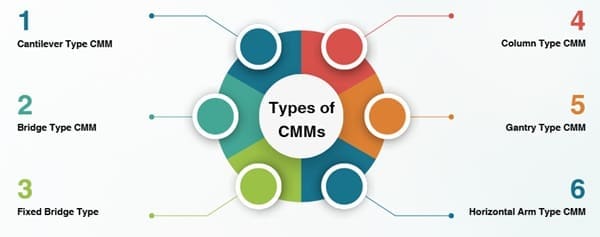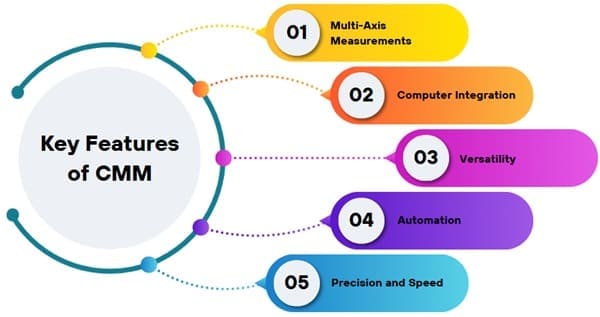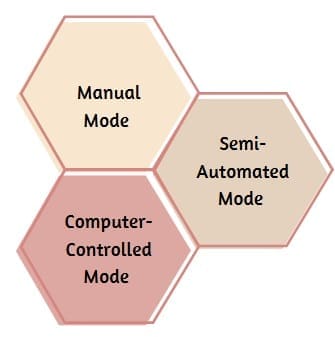An operator uses a Coordinate Measuring Machine (CMM) to measure the physical geometries of objects. These machines can measure in three-dimensional space, capturing an object’s location and orientation. CMMs are vital in industries like manufacturing, aerospace, and automotive for quality control and inspection.
The primary function of a CMM is to measure the dimensions of physical objects, compare them to predefined standards, and ensure that parts are within specifications. These machines can capture detailed data that allows for precise analysis of complex shapes and features.
Table of contents
History and Development of CMM
The concept of a CMM dates back to the 1960s in the United States. The early versions were manually operated. The modern versions emerged in the 1980s with the rise of computer technology. This development enabled computer integration, which dramatically increased the speed and precision of measurements.
The CMM is now a crucial tool in computer-integrated manufacturing (CIM) environments. The integration of a computer into the CMM allows it to perform complex tasks, such as generating 3D models and performing mathematical calculations quickly.
Types of Coordinate Measuring Machine (CMM)

CMMs come in several types, each designed for different applications and environments. The most common configurations include:
- Cantilever Type CMM
The cantilever type offers a compact size and easy access. Manufacturers typically use it for small to medium-sized parts. In this design, a cantilever arm holds the probe, enabling movement along the X, Y, and Z axes. The cantilever CMM is ideal for parts that require quick and easy inspection. - Bridge Type CMM
The bridge-type CMM is one of the most popular types due to its stability and accuracy. In tIn this design, a horizontal bridge holds the probe and moves it over the object. This design mounts the probe on a horizontal bridge that moves across the object. This structure allows for better rigidity, which improves the precision of measurements. However, it can sometimes be prone to issues like yawing, which can affect accuracy if not properly calibrated. - Fixed Bridge Type
A fixed bridge type CMM offers more stability compared to the moving bridge type. Engineers attach the bridge rigidly to the machine base to eliminate issues like yawing. This setup is especially useful for applications that require high accuracy. - Column Type CMM
Column-type Coordinate Measuring Machine (CMM) are often referred to as universal measuring machines. They provide exceptional rigidity and accuracy, making them suitable for inspecting parts that require precise measurements. Operators typically use these machines in controlled environments like gauge rooms rather than on production floors. - Gantry Type CMM
The gantry-type CMM features a design with support columns that hold the X and Y axes, while the Z-axis moves along a vertical support. This setup is ideal for large workpieces, as it allows for easy access and large measurement volumes. Industries commonly use it to measure large parts, such as car bodies or heavy components. - Horizontal Arm Type CMM
In this configuration, the probe is carried by a horizontal arm. The arm moves along the X and Y axes, while the probe can move up and down on the Z-axis. Manufacturers commonly use horizontal arm Coordinate Measuring Machine (CMM) to measure large, flat objects such as molds and dies. This type offers excellent accessibility for large workpieces.
Key Features of Coordinate Measuring Machine (CMM)

- Multi-Axis Measurements: Unlike traditional single-axis machines, a Coordinate Measuring Machine (CMM) measures in three dimensions: X-axis, Y-axis, and Z-axis.
- Computer Integration: Technicians often integrate the CMM with a computer to automate the processing of measurements and comparisons to standards.
- Versatility: It is flexible enough to measure a wide range of geometries and features without requiring additional fixtures or jigs.
- Automation: CMMs can operate in fully automated environments, increasing efficiency and reducing human error during the inspection process.
- Precision and Speed: They are capable of providing highly accurate results at high speeds, making them suitable for large-scale production environments.
Applications of Coordinate Measuring Machine (CMM)
CMMs serve a wide range of applications, especially in quality control and inspection:
- Dimensional Inspection: Technicians use Coordinate Measuring Machine (CMM) to verify that parts meet precise dimensional standards.
- Geometric Inspection: Operators employ CMMs to check geometric features such as shape, alignment, and fit.
- Reverse Engineering: Engineers use CMMs to generate detailed 3D models of existing parts for redesign or reproduction.
Structure of a CMM
A basic Coordinate Measuring Machine (CMM) consists of three main parts:
Axes: A CMM usually has three axes (X, Y, and Z) that allow movement in all three dimensions.
Carriages: Each axis has a carriage that moves along its respective direction. These carriages are powered by motors.
Probe: A probe is attached to the third axis, which makes contact with the object being measured. The probe is capable of various movements, depending on the configuration of the CMM.
A computer system controls the machine, tracking the movement of the probe across the three axes and recording the measurements.
CMM Operation and Programming
In a computer-controlled CMM, the machine operates under the direction of specialized software. The software provides three main components:
Move Commands: Directs the probe to specific points on the object for measurement.
Measurement Commands: Compares the distance traveled by the probe to a predefined standard.
Formatting Commands: Converts the raw data into the desired format, whether for display, printout, or further analysis.
Programming a CMM involves creating a sequence of commands that will guide the probe to the relevant locations on the part for measurement. These commands can be created manually or through specialized software designed for the CMM.
Advantages of CMM
CMMs offer numerous benefits that make them indispensable in modern manufacturing and quality control:
High Precision: CMMs provide extremely accurate measurements, making them ideal for quality inspections where precision is crucial.
Speed: These machines can take multiple measurements in a very short period, improving production efficiency.
Flexibility: CMMs can measure complex geometries and a wide variety of part types without the need for custom fixtures or jigs.
Automation: The ability to operate in automated systems reduces human error and enhances consistency in measurement processes.
Integration: Manufacturers can seamlessly integrate modern CMMs into Computer Integrated Manufacturing (CIM) systems, improving overall production efficiency.
Challenges of CMM
While CMMs offer significant benefits, they also have some limitations and challenges:
Cost: CMMs, especially high-precision models, can be expensive, which may not be suitable for smaller manufacturers.
Space Requirements: Some configurations, such as the gantry type, require large amounts of floor space to accommodate the equipment.
Complex Programming: Programming a CMM can be complex, especially for highly intricate or non-standard parts.
Maintenance: CMMs require regular maintenance and calibration to maintain accuracy and reliability.
Modes of Operation

CMMs can operate in several modes, depending on the level of automation and user interaction. These modes include:
Manual Mode
In manual mode, the operator manually moves the probe to the required points on the object. This mode offers flexibility but is more time-consuming and less precise than automated systems.
Semi-Automated Mode
In semi-automated mode, the operator still controls some aspects of the measurement, but digital displays and electronic systems assist with certain functions, such as setting the datum or converting dimensions.
Computer-Controlled Mode
In computer-controlled mode, the CMM operates with an onboard computer that automates most of the measurement process. This mode allows for faster and more accurate measurements, making it ideal for mass production or complex components that require high precision.
The computer directs the probe, compares measurements to standards, and processes the data to provide results.
Final Words
Coordinate Measuring Machines (CMMs) are vital tools in modern manufacturing, offering precise, fast, and flexible measurement solutions. They are used in quality control to ensure that parts meet stringent specifications. CMMs have evolved significantly over the years, with advancements in computer technology enhancing their capabilities.
As technology progresses, CMMs will continue to play a central role in improving manufacturing accuracy and efficiency. Their ability to measure in three-dimensional space, combined with the power of computer integration, makes them indispensable for industries requiring high precision.
Despite their cost and space requirements, the benefits of using CMMs in automated and high-precision environments far outweigh the drawbacks. As industries demand even higher levels of accuracy and efficiency, the role of CMMs will likely expand further, shaping the future of manufacturing and quality control.


















